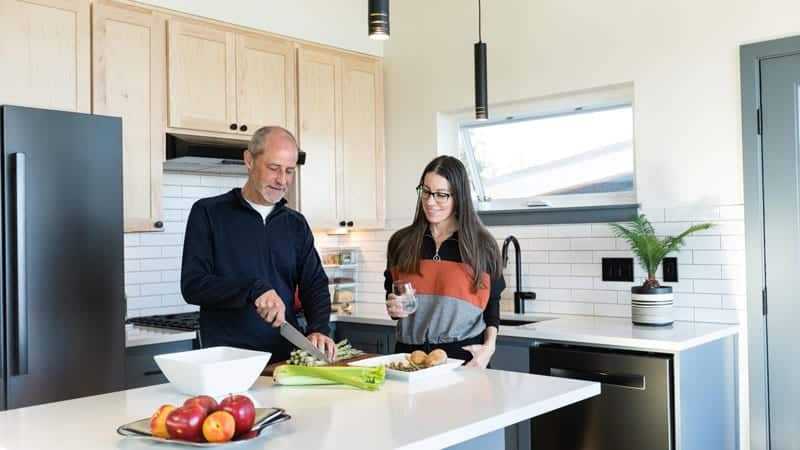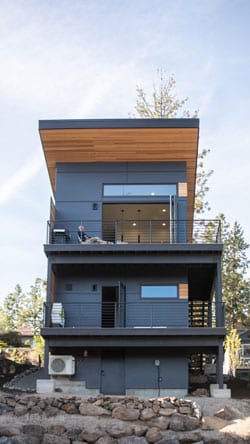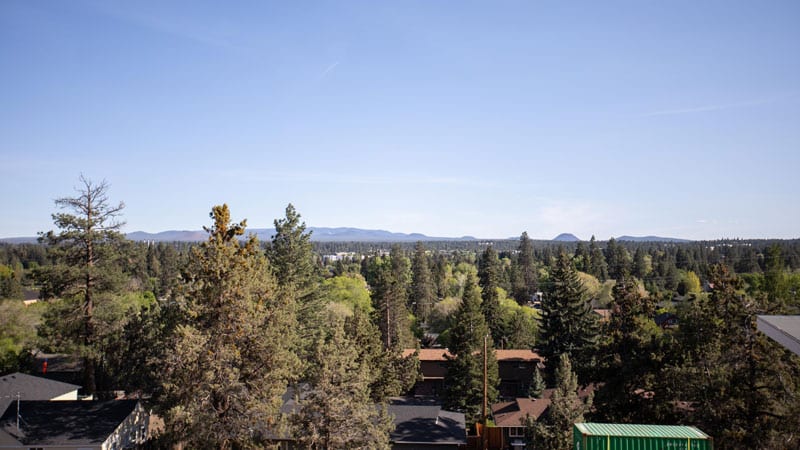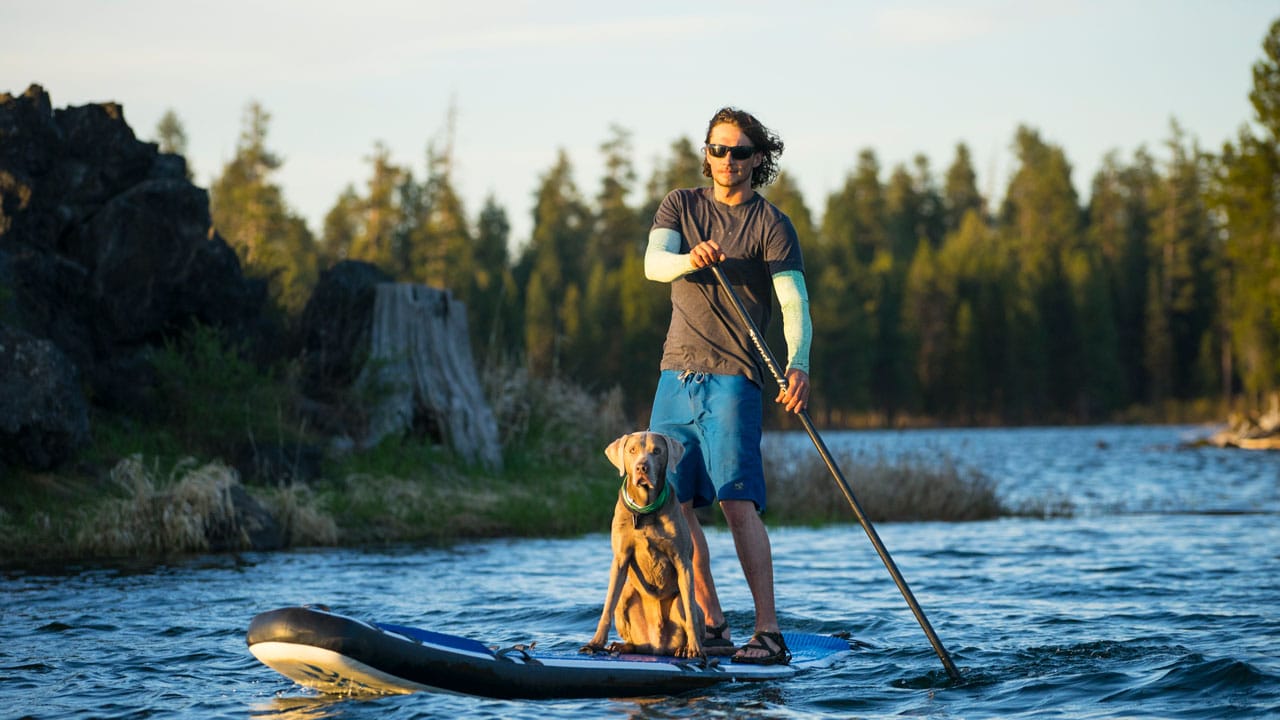When Sue and Scott Olson first entered the Vandevert Homestead in 2018, it was shuttered and inhabited by birds. But the couple saw past the crumbling structure to the clear views of Broken Top and Mount Bachelor, the sounds of the bubbling Little Deschutes River that meanders through the site and the historic importance of Vandevert Ranch.
Luckily for both the ranch and the Olsons, it was a classic example of the right people at the right time. They made an offer within an hour.
Saving a piece of history

But by the 1980s, the home’s lodgepole and ponderosa pine logs were in rough shape. According to the 2011 book Vandevert: The Hundred Year History of a Central Oregon Ranch, by Ted Haynes and Grace Vandevert McNellis, the homestead was slated for auction in 1987. Just before the place landed on the auction block, Jim Gardner, the outgoing president of Lewis & Clark College, and his wife Carol, bought the property.
They had a vision for the ranch’s restoration, but soon realized the homestead was beyond saving. Their plan was to build a replica using some of the original logs. Instead, a contractor’s mistake led to an entirely new replica log cabin. The couple also acquired adjacent acreage and developed a 400-acre gated community around the replica homestead and its Sears and Roebuck kit guest house, which had been added to the ranch in 1953. The Gardners stipulated that any new home in the Vandevert Ranch development would have to be built of log construction.
The development flourished, and to this day, Vandevert Ranch is a neighborhood consisting of twenty-two individually owned lots and common areas, including stables, dog kennels and a fly-fishing pond. It remains true to its historic roots of 130 years ago, and is considered one of the country’s finest log cabin communities, prized for its scenic location and privacy.
Eventually, the replica homestead at the center of it all began its own period of decline. “We heard that one group had it under contract and planned to tear it down for another home,” Scott said. “But the neighborhood architectural committee denied this plan. The neighbors have always understood the importance of the homestead’s history.”
Restoration Begins Anew
The Olsons hired Bend architect Jeff Klein of Klein Architecture in 2018 to oversee the design and renovation of the home and a new barn, and to shepherd them through work with the neighborhood design review committee and the nine separate county approvals necessary to receive the building permit. The guiding tenet in the homestead was to save as much of the structure as possible and create a more livable environment.
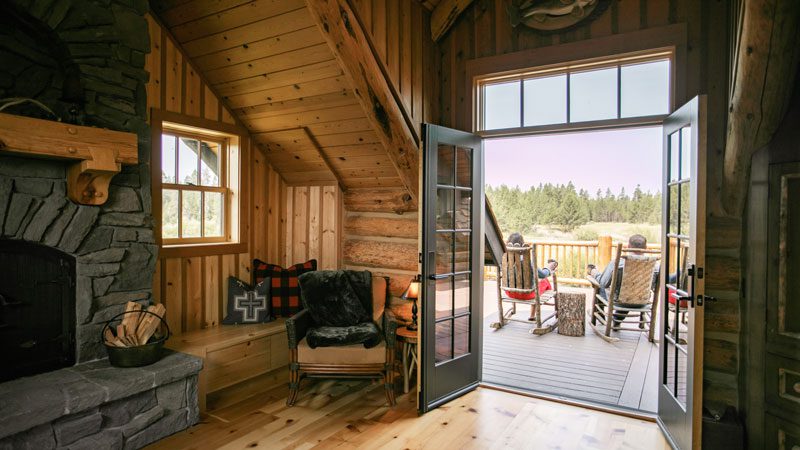
While the look and style of the exterior would remain the same, the 3,200-square-foot interior would undergo several changes and upgrades. In 2019, they began by converting a small, unusable attached garage into a sunroom. The flat roof over the garage leaked, causing extensive damage to the log structure. They retained the flat roof, but to prevent further water damage, Klein worked with the framers on designing a sloping roof system with a waterproof membrane to channel water away from the building’s exterior. This also created an ideal space for a rooftop deck, accessible from the upstairs master wing and guest bedroom.
The main floor is rectangular with four quadrants—sunroom, kitchen, living room and dining room. The sunroom functions as a casual place to hang out. In a nod to modern design, giant windows and a door open accordion-style for indoor-outdoor living. The sunroom also filters more natural light into the home. “The sunroom opened up the house and gave us more interaction with the river,” Scott said, referring to the nearby Little Deschutes.
Unlike many owners who acquire an older home and can’t wait to remodel the kitchen, the Olsons left the 1980s-era kitchen intact, including a farm sink, concrete countertops, butcher-block-island and built-in seating. They converted a former sitting room and office into a dining room with a fireplace, and furnished it with a large custom-made wood table for hosting their extended family and friends.
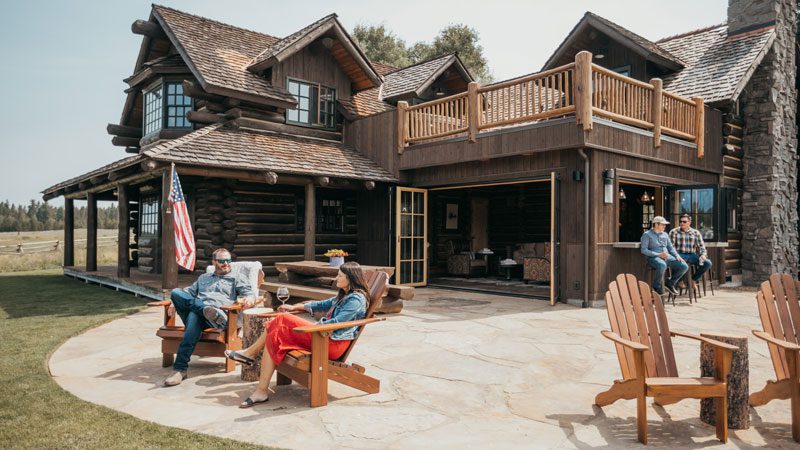
The crown jewel of the home can be glimpsed from the modest front entryway. An archway leads to the dining room on the left, while another is a gateway to the grand living room on the right. The wood-burning, stone fireplaces in each room, made with materials sourced from the property, face each other through the arches. Remarkably, Robin Zinniker, the mason who built the great room’s two-story fireplace in the 1980s, was still around to create the fireplace in the dining room, which shares a chimney with an upstairs guest bedroom fireplace.
The living room’s vaulted space with exposed timber trusses includes a wrought-iron bottom chord to carry both the tension and bending of the trusses. A large authentic antler chandelier, an elk head over the mantle, a larger-than-life-size photo of a grizzly, and Western-themed artwork and furniture are perfect complements to the massive log walls.
The living room along with other parts of the house feature the Vandevert hash knife, a tool used to cut meat. It was incorporated as the ranch logo when the Gardners developed the ranch, in a nod to the Vandevert cattle ranching family history. “We put it everywhere we could, such as the front door knocker, fireplace door handles and light fixtures,” Sue said.
The original log cabin didn’t house people who owned cars, sports equipment like skis and bikes, or even laundry rooms, but they did have barns. So, Klein designed an entirely new structure near the homestead resembling an old-fashioned barn but with all modern amenities “hidden” inside. The two-story “barn” features a three-car garage, laundry, gear room, Scott and Sue’s office and an entertainment room with a covered outside deck and views of the mountains.
With the renovated homestead, the new barn and the Sears and Roebuck kit guest house comprising the Olson compound, the family is enjoying its lifestyle on the historic Vandevert Ranch. “We have a home for all seasons,” Sue said. “We love the roaring fires and snow in the winter, and in the summer, sitting at the river with people floating by our dock. We have many ways to enjoy nature. We feel honored to have had the opportunity to restore this property with its historical significance.”
Scott added that they have friends still searching for their special place, “But we’ve found our home. We’re here for the long-term and who knows? Maybe grandkids in the future.”
Resources
Project Planning, Entitlements and Approvals: Vandevert Ranch HOA Board of Directors, Vandevert Ranch Design Review Committee, and Deschutes County Historic Preservation and
Historic Landmarks Commission
Architecture: Jeffrey Klein, Klein Architects
Interior Design: Sue Olson
Structural Engineering: Rolf Armstrong, Eclipse Engineering, P.C.
Homestead and Guest Home Renovation General Contractor: Bales, Inc.
Barn General Contractor: Stillwater Construction
Finish Carpentry: Nick Fancher
Landscape Design and Construction: Land Effects, Inc.
Hand Forged Ironwork: Ponderosa Forge
Log Construction: George Garcia
Custom Dining Table: Brent Taylor

